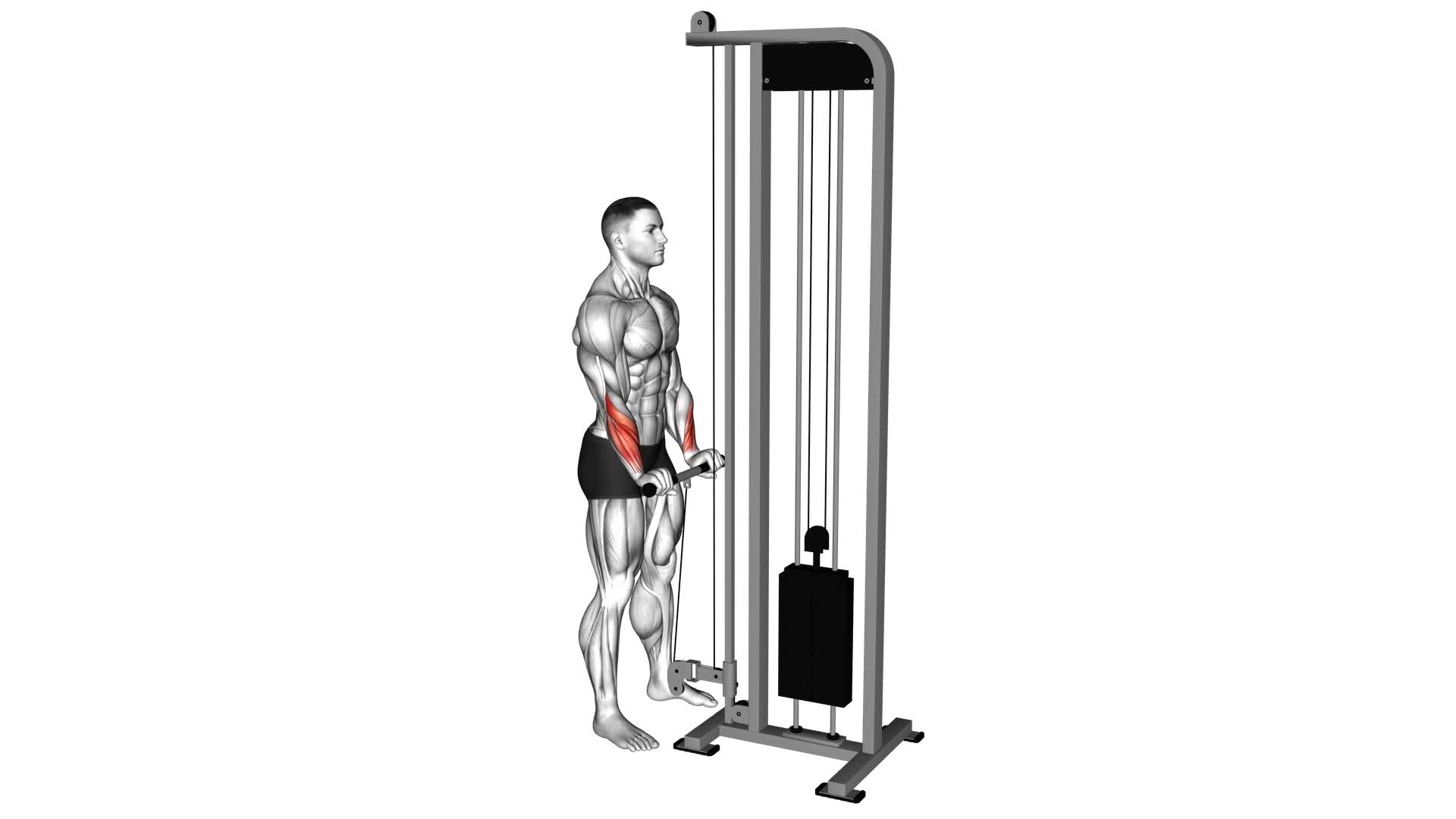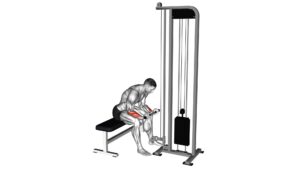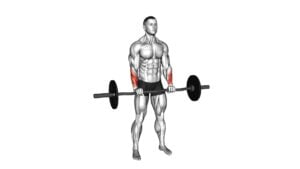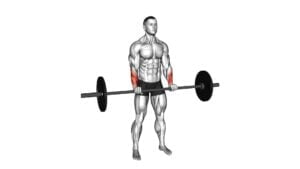Cable Standing Wrist Reverse Curl – Video Exercise Guide & Tips

Get ready to strengthen your wrists with the Cable Standing Wrist Reverse Curl! This exercise targets your forearm muscles, improving grip strength and wrist stability.
Watch This Exercise Video
In this video exercise guide, we'll walk you through the proper form and technique, tips for maximizing effectiveness, common mistakes to avoid, and variations for progression.
With our step-by-step instructions and expert tips, you'll be on your way to stronger wrists in no time.
Let's get started!
Key Takeaways
- The cable standing wrist reverse curl is an alternative exercise to the dumbbell variation.
- Incorporating wrist exercises can contribute to overall upper body strength.
- Maintaining proper form and control is crucial for maximizing effectiveness and preventing injury.
- Progressions and variations, such as using resistance bands or barbells, can be used to continuously challenge oneself and enhance the workout routine.
Equipment Needed for Cable Standing Wrist Reverse Curl
To perform the Cable Standing Wrist Reverse Curl, you'll need a cable machine with an adjustable attachment. This exercise provides several benefits, including targeting the muscles in your forearms and wrists, improving grip strength, and enhancing overall upper body strength. It's a great alternative to traditional wrist curls and can be done by individuals of all fitness levels.
The cable machine is an essential piece of equipment for this exercise. It allows for constant tension throughout the movement, providing a more effective workout for your wrists and forearms. The adjustable attachment allows you to set the appropriate height for your height and range of motion.
While the cable machine is the recommended equipment for this exercise, there are a few alternatives you can try if you don't have access to one. Dumbbells or resistance bands can be used as a substitute for the cable machine. Simply hold the dumbbells in your hands with your palms facing down or loop the resistance bands around a sturdy object and hold the ends with your palms facing up.
Now that you know the equipment needed for the Cable Standing Wrist Reverse Curl and some alternatives, let's move on to the proper form and technique for this exercise.
Proper Form and Technique for Cable Standing Wrist Reverse Curl
To perform the Cable Standing Wrist Reverse Curl with proper form and technique, follow these guidelines.
- Stand facing a cable machine with your feet shoulder-width apart and your knees slightly bent.
- Grasp the cable handle with an overhand grip and extend your arms straight in front of you, keeping your elbows close to your body. This is your starting position.
Now, perform the movement:
- Slowly curl your wrists towards your body, keeping your arms stationary and your elbows locked in place.
- Focus on using your wrist muscles to perform the movement, rather than relying on your biceps or forearms.
- Exhale as you curl your wrists and squeeze your wrist muscles at the top of the movement. Hold for a brief pause.
- Slowly lower the cable handle back to the starting position, inhaling as you do so.
It's important to maintain proper form:
- Avoid using excessive weight, which can lead to improper form and strain on the wrists. Start with a lighter weight and gradually increase as your strength improves.
- Keep your elbows locked in place and your arms stationary throughout the exercise. Avoid allowing the elbows to move or the arms to swing.
Tips for Maximizing the Effectiveness of Cable Standing Wrist Reverse Curl
Maximize the effectiveness of your Cable Standing Wrist Reverse Curl by incorporating these tips into your workout routine.
- Maintain proper form: One of the most common mistakes in performing the Cable Standing Wrist Reverse Curl is swinging the arms or using momentum to lift the weight. To maximize effectiveness, focus on keeping your upper arms stationary and engage your wrist muscles to lift the weight. This ensures that the targeted muscles are being worked properly.
- Use appropriate weight: It's important to select a weight that challenges your wrist muscles without compromising your form. Start with a lighter weight and gradually increase as you build strength. Using too heavy of a weight can lead to injury and ineffective results.
- Control the movement: Slow and controlled movements are key to maximizing the benefits of the Cable Standing Wrist Reverse Curl. Avoid rushing through the exercise and instead focus on the contraction of your wrist muscles as you lift the weight. This will engage the muscles more effectively and lead to better results.
Common Mistakes to Avoid When Performing Cable Standing Wrist Reverse Curl
When performing the Cable Standing Wrist Reverse Curl, it's important to avoid common mistakes that can hinder your progress and effectiveness.
One common mistake is using too much weight. It may be tempting to load up the cable machine with heavy weights, but this can put excessive strain on your wrists and lead to injury. Start with a lighter weight and focus on proper form and technique before gradually increasing the resistance.
Another mistake is using improper wrist positioning. During the exercise, it's crucial to keep your wrists in a neutral position and avoid excessive flexion or extension. This helps to target the muscles in your forearms more effectively and prevents unnecessary strain on your joints.
Lack of control is another common mistake to avoid. It's important to perform the exercise in a slow and controlled manner, focusing on the eccentric (lowering) phase as much as the concentric (curling) phase. Rushing through the exercise can compromise form and reduce the effectiveness of the exercise.
By avoiding these common mistakes, you can maximize the benefits of the Cable Standing Wrist Reverse Curl. It helps to strengthen your wrist flexors and extensors, improves grip strength, and enhances overall forearm development.
Now, let's move on to the next section to explore variations and progressions for the cable standing wrist reverse curl.
Variations and Progressions for Cable Standing Wrist Reverse Curl
To maximize your workout and continue challenging yourself, there are several variations and progressions you can incorporate into your Cable Standing Wrist Reverse Curl routine. These variations and progressions will help you target different muscles and increase your wrist strength. Here are three alternative exercises for wrist strength training:
- Dumbbell Wrist Curls: Hold a dumbbell in your hand with your palm facing up. Rest your forearm on a bench or your thigh and allow your wrist to hang over the edge. Curl your wrist up towards your body, then slowly lower it back down. Repeat for the desired number of repetitions.
- Barbell Reverse Curls: Stand with your feet shoulder-width apart and hold a barbell with an overhand grip, palms facing down. Keep your elbows close to your body and curl the barbell up towards your shoulders, focusing on contracting your wrist flexors. Slowly lower the barbell back down and repeat.
- Hammer Curls: Hold a dumbbell in each hand with your palms facing your body. Keeping your elbows close to your sides, curl the dumbbells up towards your shoulders while maintaining a neutral grip. Slowly lower the dumbbells back down and repeat.
Incorporating these alternative exercises into your wrist strength training routine will help you continue to challenge your muscles and improve your overall strength and stability.
Frequently Asked Questions
How Many Repetitions Should I Do for the Cable Standing Wrist Reverse Curl Exercise?
To get the most out of the cable standing wrist reverse curl exercise, it's important to determine the right number of repetitions for you.
The recommended number of repetitions for this exercise varies depending on your fitness level and goals. Doing 8-12 repetitions per set is a good starting point for building strength and muscle endurance. However, it's always best to consult with a fitness professional to tailor the repetitions recommendation to your specific needs.
The benefits of this exercise include improving grip strength and forearm muscle development.
Can I Use Dumbbells Instead of a Cable Machine for This Exercise?
Yes, you can definitely use dumbbells instead of a cable machine for the cable standing wrist reverse curl exercise. While the cable machine provides a constant tension throughout the movement, dumbbells allow for a greater range of motion and targeting of the wrist flexors.
Make sure to use a weight that challenges you while maintaining proper form. Keep your wrists straight and curl the dumbbells up towards your forearms, then slowly lower them back down to the starting position.
Is It Necessary to Warm up Before Performing the Cable Standing Wrist Reverse Curl?
Yes, it's necessary to warm up before performing the cable standing wrist reverse curl. Warming up has many benefits, such as increasing blood flow to the muscles, improving flexibility, and preventing injuries.
If you don't have access to a cable machine, there are alternative exercises you can do, such as dumbbell wrist curls or barbell wrist curls. These exercises will also target your wrist flexor muscles effectively.
Will This Exercise Help With Wrist Pain or Injury?
Incorporating wrist exercises into your workout routine has many benefits. It can help strengthen the muscles and improve flexibility, which may reduce the risk of wrist injuries during exercise.
By performing exercises like the Cable Standing Wrist Reverse Curl, you can target the wrist extensor muscles and potentially alleviate wrist pain or injury.
However, it's important to consult with a professional and ensure proper form to avoid further damage or strain.
Can I Incorporate This Exercise Into My Regular Arm Workout Routine?
Yes, you can definitely incorporate the Cable Standing Wrist Reverse Curl into your regular arm workout routine. This exercise targets the muscles in your wrists and forearms, helping to strengthen and stabilize them.
It can be a great addition to other wrist exercises you may already be doing. By incorporating this exercise, you can experience the benefits of wrist strengthening, which can improve your overall arm strength and prevent wrist pain or injury.
Conclusion
In conclusion, the cable standing wrist reverse curl is a highly effective exercise for targeting the muscles in the forearms and wrists. By utilizing proper form and technique, along with incorporating variations and progressions, individuals can maximize the effectiveness of this exercise.
It's important to avoid common mistakes and to use the appropriate equipment to ensure safety and optimal results.
Overall, the cable standing wrist reverse curl is a valuable addition to any strength training routine.

Author
Years ago, the spark of my life’s passion ignited in my mind the moment I stepped into the local gym for the first time. The inaugural bead of perspiration, the initial endeavor, the very first surge of endorphins, and a sense of pride that washed over me post-workout marked the beginning of my deep-seated interest in strength sports, fitness, and sports nutrition. This very curiosity blossomed rapidly into a profound fascination, propelling me to earn a Master’s degree in Physical Education from the Academy of Physical Education in Krakow, followed by a Sports Manager diploma from the Jagiellonian University. My journey of growth led me to gain more specialized qualifications, such as being a certified personal trainer with a focus on sports dietetics, a lifeguard, and an instructor for wellness and corrective gymnastics. Theoretical knowledge paired seamlessly with practical experience, reinforcing my belief that the transformation of individuals under my guidance was also a reflection of my personal growth. This belief holds true even today. Each day, I strive to push the boundaries and explore new realms. These realms gently elevate me to greater heights. The unique combination of passion for my field and the continuous quest for growth fuels my drive to break new ground.







